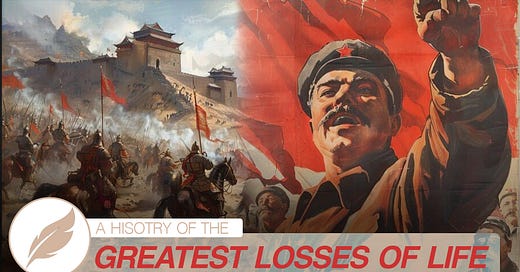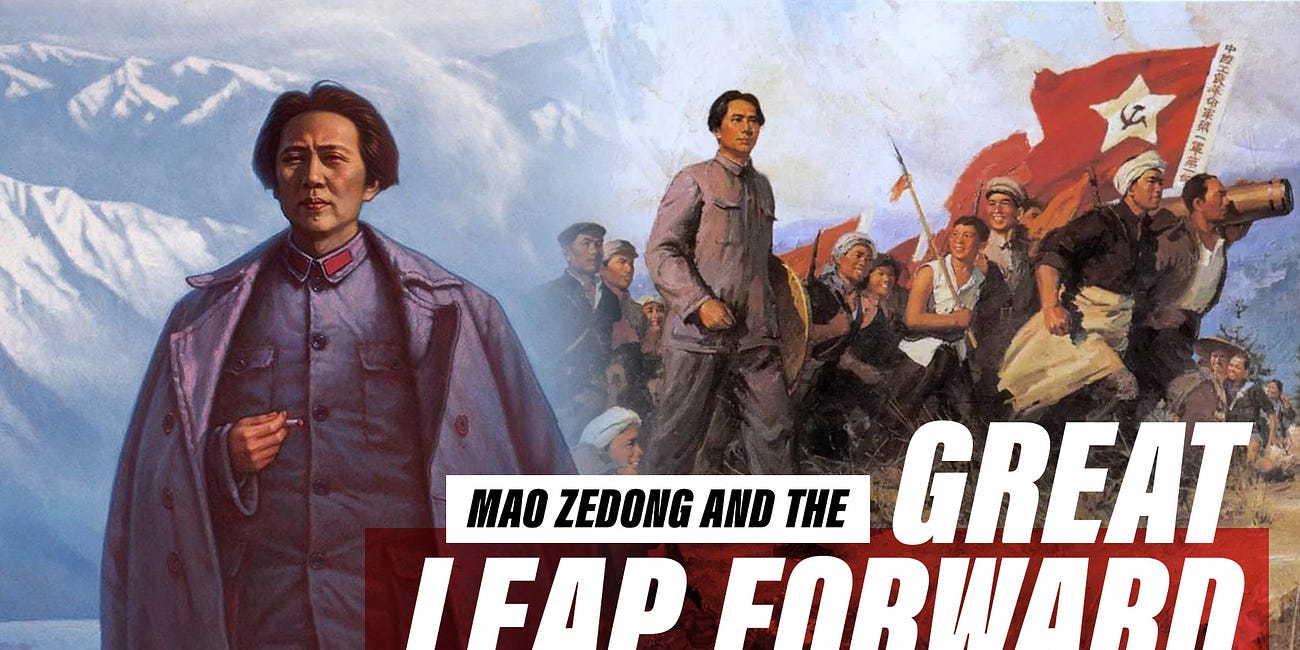There have been an incredible number of wars, genocides, conquests and natural disasters that have killed a staggering number of people throughout human history. Conquests and genocides can often be accompanied by disease and starvation and number of fatalities can be difficult to ascertain. There have been many acts of genocide that have killed a significant portion of a particular population, and hardly a people group that doesn’t have events of massive bloodshed in their history.
In this video we are going to look at a few of the largest losses of life in human history according to estimated number of dead, either as a direct or indirect outcome of the event. Estimates vary widely and what we present is open to debate, and we are only presenting what is commonly reported. We also recognise there have been many devastating and deadly events that have impacted particular regions or people groups, but with death tolls well under the tens of millions we are about to explore. Pol Pot, for example, exterminated a quarter of the Cambodian population within 4 years. Up to 80% of the Herero people and half of the Nama people were killed in response to an uprising at the turn of last century, and the list goes on.
So, without diminishing the importance of the many deaths through genocide, human trafficking, and untold number of wars, let’s consider some of the largest losses of life in recorded history.
10. The Late Qing Dynasty Famines, including the Great Chinese Famine (1876-1879):
The Great North China Famine, also known as the Northern Chinese Famine of 1876–1879, was a devastating famine that occurred in northern China during the late Qing Dynasty. It has been estimated that the famine could have resulted in as many as 10 million deaths, making it one of the deadliest famines in recorded history. Triggered by a combination of natural disasters, including droughts, floods, and locust infestations, the famine resulted in widespread crop failures and food shortages across the affected regions. Compounding the agricultural crisis, government mismanagement, corruption, and inadequate relief efforts exacerbated the suffering of the population. Millions of people, primarily in the provinces of Shandong, Henan, Shaanxi, and Zhili (modern-day Hebei), faced starvation, disease, and destitution as a result of the famine's impact.
9. World War I (1914-1918):
World War I, also known as the Great War, was a global conflict that lasted from 1914 to 1918 and resulted in staggering loss of life. Fought primarily in Europe but involving countries from around the world, World War I saw unprecedented levels of destruction and casualties. The war was characterized by trench warfare, chemical weapons, and new military technologies that contributed to immense suffering and death. By the time the war ended in 1918, the total death toll is estimated to have surpassed 15 million people, with millions more wounded or missing. The Central Powers (Germany, Austria-Hungary, the Ottoman Empire, and Bulgaria) suffered significant losses of over 4 million military and 3 million civilians killed. However, the Entente Powers (including France, the British Empire, Russia, Italy, and later the United States) collectively experienced higher overall casualties with 5.7 million military and 3.6 million civilians killed. The scale of loss was catastrophic, with soldiers and civilians alike enduring the horrors of battle, disease, and famine.
8. Tamerlane (1370-1405):
Tamerlane, also known as Timur the Lame, was a Turko-Mongol conqueror who rose to power in Central Asia in the late 14th century. He established the Timurid Empire, which encompassed parts of modern-day Iran, Central Asia, the Caucasus, and the Indian subcontinent. Tamerlane's military campaigns were marked by brutal conquests, widespread destruction, and immense cruelty. He conducted numerous campaigns of conquest, targeting neighboring states, cities, and regions, and his armies inflicted staggering levels of violence on those who opposed him. Tamerlane's conquests were characterized by the massacre of civilians, the destruction of cities, and the enslavement of captives. Despite his brutal methods, Tamerlane was also a patron of the arts and architecture, contributing to the cultural and intellectual development of his empire.
The death toll resulting from Tamerlane's conquests is difficult to determine precisely, however, historians generally agree that Tamerlane's campaigns led to the deaths of millions of people, maybe as high as 17 million, about 5% of the world population at the time. This immense loss of life, both on the battlefield and among civilian populations, as well as widespread devastation and suffering across the regions he conquered, makes Tamerlane one of the most notorious and ruthless conquerors in history.
6. The Mongol Conquests (13th century):
Under Genghis Khan and his successors, the Mongol expansion across Asia and into Europe resulted in the deaths of tens of millions of people. The death toll from these invasions of northern China from 1210 to 1219 and from 1311 to 1340 are estimated to have been anywhere from 35 million to 60 million.
In the early 13th century, under the leadership of Genghis Khan, the Mongol Empire embarked on a series of invasions of northern China, targeting the Jin Dynasty. These invasions, which took place from 1210 to 1219, were part of Genghis Khan's broader campaign to expand Mongol territories and consolidate power in the region. Employing superior tactics, mobility, and coordination, the Mongol forces inflicted significant defeats on the Jin Dynasty, capturing key cities and territories in northern China. These victories laid the groundwork for the eventual conquest of the Jin Dynasty and paved the way for further Mongol expansion into China and beyond.
From 1311 to 1340, the Mongol Empire, now under the leadership of Genghis Khan's grandson, Kublai Khan, continued its conquests in northern China, targeting the remnants of the Song Dynasty. These conquests culminated in the fall of the Southern Song Dynasty in 1279, but pockets of resistance persisted in southern China. Kublai Khan launched a series of campaigns to subjugate these remaining territories, gradually extending Mongol control over the entire Chinese mainland. Employing a combination of military might, political maneuvering, and siege warfare, the Mongols gradually dismantled the remaining Song resistance and consolidated their rule over China, establishing the Yuan Dynasty in 1271. The conquests of this period solidified Mongol dominance over China for nearly a century.
5. The An Lushan Rebellion (755-763):
The An Lushan Rebellion, which took place in China from 755 to 763 during the Tang Dynasty, was one of the most devastating civil wars in Chinese history. The rebellion was led by An Lushan, a general of mixed Sogdian and Turkic origin who had risen to prominence within the Tang military. An Lushan rebelled against the Tang Dynasty, proclaiming himself emperor and establishing the Yan Dynasty in the northern and northeastern regions of China. The rebellion was fueled by a combination of factors, including ethnic tensions, economic grievances, and political instability within the Tang government. It resulted in widespread devastation, with battles, sieges, and massacres with significant battles happening during the years 756-57. This rebellion led to the deaths of an estimated 13 million to 36 million people, as a result of warfare, famine, disease, and displacement of populations across China.
4. Taiping Rebellion (1850-1871):
The Taiping Rebellion (1850-1871) was a massive civil war in China led by Hong Xiuquan, who claimed to be the younger brother of Jesus Christ. Xiuquan gained a significant following through a combination of religious fervor, socio-economic grievances, and effective propaganda. His claim of being the younger brother of Jesus Christ and his message of establishing a "Heavenly Kingdom of Great Peace" resonated with many Chinese peasants who were experiencing hardship and were drawn to the promise of salvation and a better life. The rebellion sought to overthrow the ruling Qing dynasty and establish the Taiping Heavenly Kingdom, a utopian state based on a unique blend of Christianity and Chinese millenarianism.
The conflict resulted in widespread devastation, and a staggering death toll, with estimates commonly cited as ranging from 20 million to 30 million people, though some figures go as high as 70 million, making it one of the deadliest wars in human history. Qing forces suffered significant losses in battles, sieges, and campaigns against the Taiping rebels over the course of the rebellion, and after more than a decade of fighting, the rebellion was ultimately suppressed by Qing imperial forces with the support of Western powers.
3. Joseph Stalin's Regime in the Soviet Union:
Joseph Stalin's Regime in the Soviet Union - including the Great Purge, the Holodomor (the forced famine in Ukraine), and Gulag labor camps - resulted in a staggering loss of life. Scholarly estimates for the number of human casualties under Soviet communism are between 30 to 40 million, excluding those killed in the `Great Patriotic War'. However, estimates have been highly contentious. Nobel-prize winner Aleksandr Solzhenitsyn put the total as high as 66,700,000 for the period between October 1917 and December 1959. Whereas demographer Steven Rosefielde has estimated the death toll under Stalin's rule to be around 20 million. Similarly, the historian Robert Conquest, in his book "The Great Terror: Stalin's Purge of the Thirties," also estimated that around 20 million people perished as a result of Stalin's policies. There is no doubt that many tens of millions have died either directly or indirectly as a consequence of Soviet ideology.
For an in-depth look at one of the ideologically driven policies that caused much devastation, check out our video “How Lysenko Killed Millions”.
The Dark History of Lysenko
It is said that 200 million people died under communism in the 20th century. Among the many culprits responsible for creating such terrible conditions was Trofim Lysenko, who's 'revolutionary' agricultural concepts cost the Soviet Union and China millions of lives.
2. Mao Zedong's Policies in China (1949-1976):
Mao Zedong’s policies in China through the middle of the 20th century, like those of Stalin, resulted in tens of millions of deaths.
Including the Great Leap Forward and the Cultural Revolution, estimates of deaths under Mao Zedong vary widely. A US Senate Committee of the Judiciary in July 1971 estimated the death toll to be between 32.25 and 61.7 million. Jean-Pierre Dujardin published an estimate of 63.7 million in 1978. The political scientist R.J. Rummel in his book "China's Bloody Century: Genocide and Mass Murder Since 1900," estimates that Mao Zedong's regime was responsible for the deaths of approximately 77 million, which includes the Great Famine, the Cultural Revolution, and other campaigns. Jung Chang and Jon Halliday, also suggest that Mao was responsible for the deaths of up to 70 million people. These largest estimates, however, have been criticized for their methodology and political bias.
Limited access to historical records, censorship in China, and ideological biases among researchers, all make it difficult to pin down the total number of deaths. For a deeper look at the legacy of Mao Zedong, watch our video “the great leap forward – China’s great catastrophe”.
The Great Leap Forward
From the communist victory in 1949, the Chinese people were subjected to various economic and social experiments under Mao Tse-Tung. This would culminate in the complete collectivisation and the beginning of the 'Great Leap Forward' campaign, which would kill tens of millions. It is just one of many destructive experiments undertaken by Mao.
1. World War II (1939-1945):
World War 2 was arguably the deadliest conflict in human history, with an estimated 70 to 85 million fatalities, including civilians and military personnel. Military deaths were between 21 to 25.5 million, while civilian deaths include 29 million to 30.5 million from military and war crimes, plus another 19 million to 28 million due to war-related famine and/or disease. The Soviet Union (20 to 27 million) and China (15 to 20 million) are believed to have suffered the most casualties.
Among the Soviet Union's 15 republics, Russia withstood the highest number of casualties, with 6,750,000 military deaths and 7,200,000 civilian deaths. Ukraine tallied the second-highest casualties, with 1,650,000 military deaths and 5,200,000 civilian deaths.
In China there were up to 3.75 million military deaths and 18.19 million civilian deaths. Some experts believe that Soviet and Chinese civilian casualty numbers may be significantly underestimated due to famine and disease.
The next most significant losses were Germany (6 to 7.4 million), Poland (5.9 to 6 million), Dutch East Indies/Indonesia (3 to 4 million), and Japan (2.5 to 3.1 million).
The United Kingdom suffered 450,900 deaths and the United States 419,400.
______
There have been hundreds of wars since nineteen-hundred, with the Imperial War Memorial suggesting an estimate of 187 million having died as a direct consequence of these conflicts, and this may very well be an underestimate. That’s the equivalent of four-thousand-one-hundred-and-sixty-five people being killed every day for the past 123 years. A sobering statistic, and a sad legacy for the modern world.













Share this post